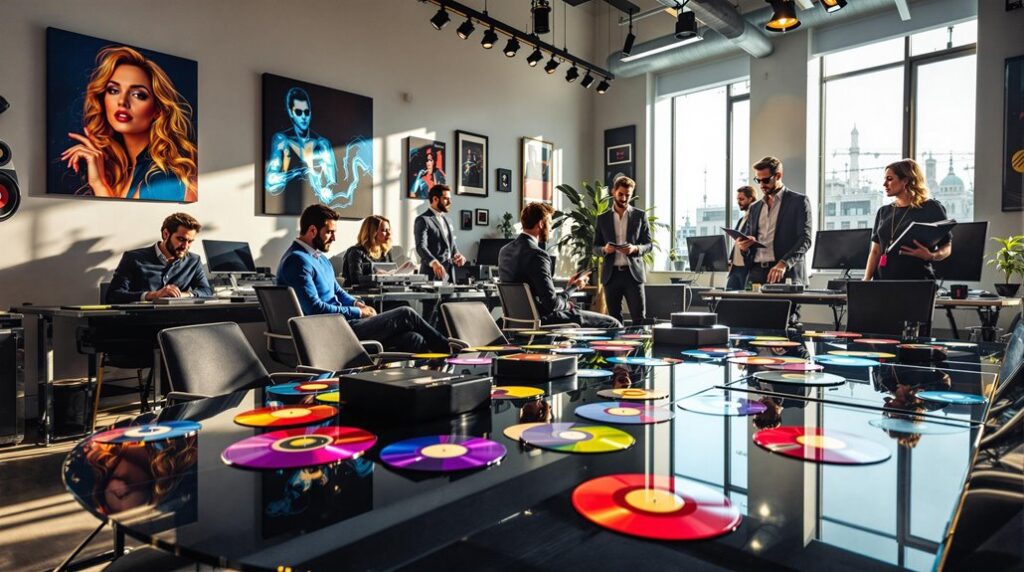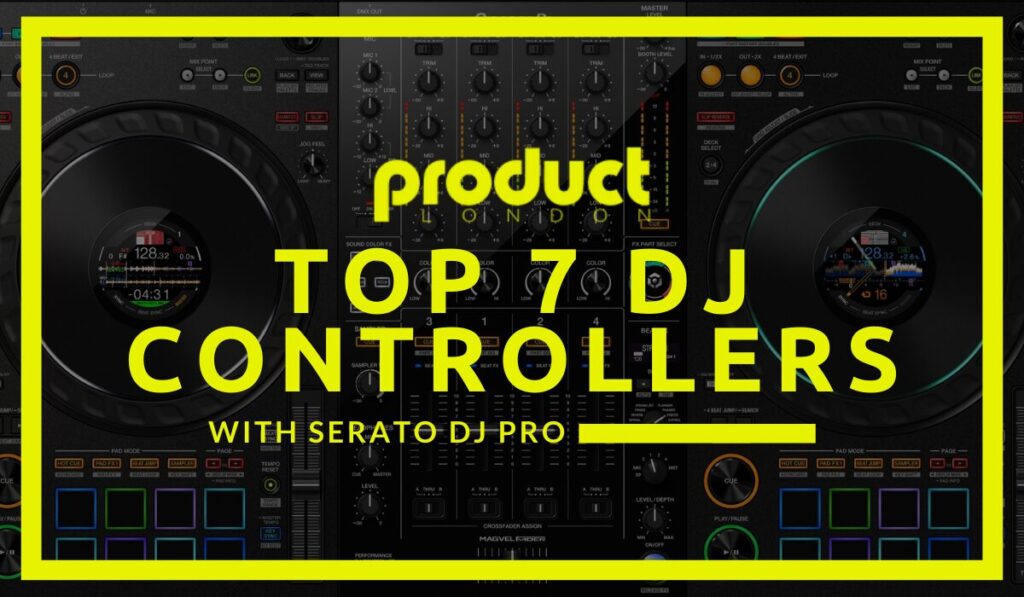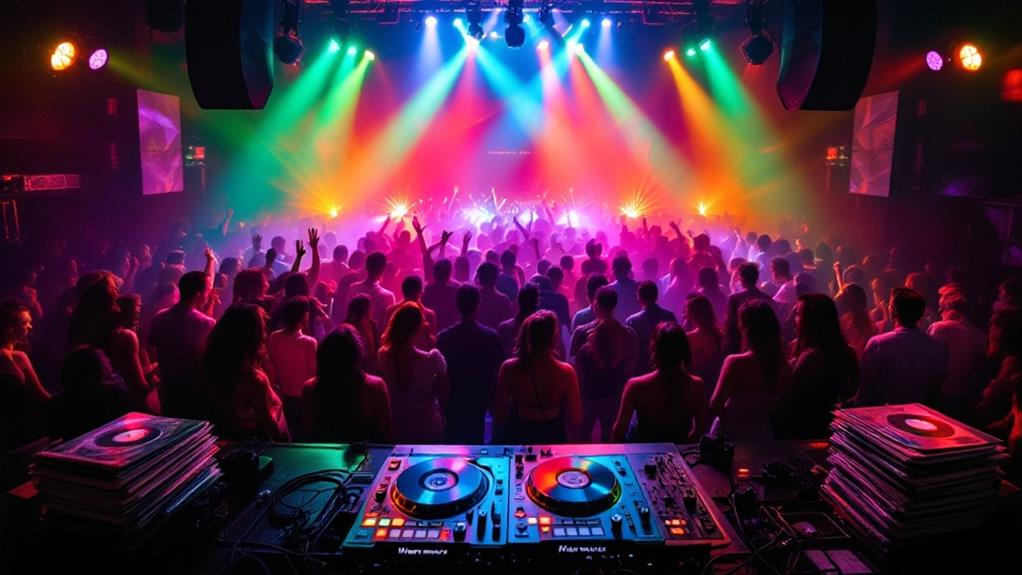Building a DJ website to showcase your skills necessitates a strategic approach. Start by understanding the DJ market and establishing a strong brand identity. Essential website features should include a bio page, news/events section, portfolio, track, and mixes page, and a contact page. Optimize design and user experience with responsive layouts and high-quality visuals. Enhance SEO with targeted keywords in content, meta tags, and alt text. Integrate media such as embedded audio players and videos to engage visitors. Regular maintenance and updates boost performance and relevance. Stay tuned for deeper insights into optimizing each website component for maximum impact.
Key Takeaways
- Create a professional bio page to highlight your background, influences, and notable performances.
- Integrate audio players and video clips to showcase your mixes and live performances.
- Include a news/events section to keep fans informed about upcoming gigs and releases.
- Ensure mobile optimization for seamless access across various devices and improve user experience.
- Utilize local keywords and regularly update content to enhance SEO and online visibility.
Understanding the DJ Market
The DJ market, a thriving segment within the global entertainment industry, is currently valued at over $7 billion, with an impressive projected annual growth rate of 5.4% and a compound annual growth rate (CAGR) of 10% from 2020 to 2027. This significant growth can be attributed to increasing disposable incomes and heightened spending on entertainment, resulting in higher demand for DJs at various events, including weddings, parties, and corporate functions.
A vital aspect of DJ market trends is the emphasis on quality music, which leads event planners to prioritize professional DJs. This focus has expanded the market into various niches, such as children’s parties and themed events, each requiring a specific understanding and approach. Niche market analysis reveals that DJs catering to these specialized segments can achieve higher engagement and client satisfaction.
For those seeking to break into the corporate market, understanding diverse tastes and tailoring playlists accordingly is essential.
In addition, the DJ equipment market, valued at approximately $6.1 billion in 2022, underscores the robust investment and growth within the sector. Regional preferences play a pivotal role in shaping the DJ market, as they influence the music styles and event types that appeal to distinct audience demographics.
Understanding these preferences is vital for DJs aiming to tailor their services effectively.
Building a Strong Brand
Understanding the DJ market dynamics underscores the necessity of creating a robust brand identity to thrive in this competitive industry. Establishing a unique DJ persona is vital, as it differentiates you in a market valued at over $7 billion globally. Effective branding strategies are essential to attract clients and build a strong presence. Integrating targeted keywords into your branding efforts can enhance visibility and searchability online.
A consistent visual identity across all platforms is paramount. This includes high-quality visuals and engaging content on social media and promotional materials, enhancing recognition and credibility. Professional promotional materials, such as business cards and flyers, should reflect your style and services to establish a credible image.
Collaborating with local venues and event planners can greatly boost brand visibility and reputation, particularly within niche markets like children’s parties and themed events. Such collaborations not only enhance brand presence but also foster positive word-of-mouth.
Incorporating customer reviews and testimonials into your branding strategy is another critical element. These endorsements build trust and are highly regarded by event planners prioritizing quality and reputation. As a result, leveraging positive feedback can attract new clients and solidify your standing in the DJ community.
Ultimately, a strong brand identity, supported by strategic and consistent branding efforts, is fundamental to success in the DJ industry.
Essential Website Features
A professional DJ website must incorporate key content pages, including a bio, event schedule, music mixes or tracks, testimonials, and a contact page, to provide thorough information for potential clients and fans.
Additionally, integrating interactive media elements such as high-quality visuals, embedded music players, and social media widgets enhances user engagement and showcases the DJ’s work effectively.
To guarantee a cohesive and professional look, maintain brand consistency with colors, fonts, and logos throughout the site.
Employing these essential features guarantees a robust online presence, facilitating increased bookings and audience growth.
Key Content Pages
Crafting a professional DJ website requires meticulous attention to several key content pages that form the backbone of its functionality and appeal.
These pages not only enhance user experience but also effectively showcase your skills and services.
1. Bio Page: This page is essential for bio storytelling, offering insights into your background, influences, and journey.
It should highlight performance highlights and notable gigs, establishing your credibility and personal brand.
2. News/Events Section: Keeping fans updated on upcoming gigs, releases, and other important news guarantees they stay engaged and informed.
Regular updates in this section are vital for maintaining ongoing interest and building anticipation for future performances.
3. Track and Mixes Page: Utilizing platforms like SoundCloud and MixCloud, this page should feature your latest mixes and tracks.
It serves as an auditory portfolio, attracting new listeners and potential clients enthusiastic to experience your style and technical prowess.
4. Portfolio Page: Including high-quality visuals and videos of past performances, this page offers a vivid glimpse into your DJing style and energy.
Such a visual representation of your skills can greatly enhance your credibility and appeal to prospective clients.
Regularly updating these pages guarantees continued relevance and engagement, fostering a dynamic and compelling online presence.
Interactive Media Elements
To guarantee a DJ website is both engaging and functional, incorporating interactive media elements is essential. Implementing audio functionality through embedded audio players allows visitors to stream your mixes directly, providing an immediate auditory experience that can greatly boost engagement and increase the likelihood of bookings.
Additionally, video integration—such as performance clips or promotional reels—adds a dynamic visual dimension to your site, effectively showcasing your skills and stage presence to potential clients.
Interactive elements like an integrated calendar or booking form further enhance user experience by streamlining the process for clients to check your availability and book gigs. This not only improves efficiency but also reduces friction in the booking process, making it easier for clients to commit.
Furthermore, including social media integration facilitates easy sharing of your content, leveraging your existing audience to expand your reach and attract new followers.
A blog section dedicated to articles about your experiences, industry tips, or music trends not only highlights your expertise but also boosts your website’s SEO, making it more discoverable to potential clients.
Design and User Experience
User experience (UX) is paramount when designing a DJ website, requiring meticulous attention to navigation, visual appeal, and functionality. A well-structured site guarantees easy navigation with clear menus and accessible content, keeping visitors engaged and encouraging exploration.
Establishing a robust visual hierarchy is essential to guide users effortlessly through the site, highlighting key elements like performance videos and professional images to enhance aesthetic appeal. Incorporating user feedback in the design process can help identify potential pain points, guaranteeing that the site offers an intuitive and seamless experience.
Engaging with users through high-quality visuals and interactive elements can greatly boost user retention and satisfaction.
To achieve a superior user experience, consider the following key aspects:
- Mobile Optimization: With over 50% of web traffic coming from mobile devices, guaranteeing your website is responsive and functional on all screen sizes is critical for user retention.
- Load Times: Optimizing images and utilizing fast hosting to achieve a PageSpeed score of 90+ greatly improves performance and reduces bounce rates.
- Clear Calls-to-Action (CTAs): Strategically placed CTAs like “Book Now” or “Listen to My Mixes” guide users toward desired actions, enhancing conversion rates.
- High-Quality Visuals: Professional images and engaging videos of performances enrich the site’s visual appeal, encouraging visitors to stay longer.
SEO and Online Visibility
In the domain of SEO and online visibility, optimizing for relevant keywords related to DJ services, genres, and local events is imperative for ensuring that potential clients can easily find your site.
Equally essential is enhancing the mobile experience, as half of all web traffic originates from mobile devices and search engines favor mobile-friendly websites.
Optimize for Keywords
Optimizing your DJ website for keywords is essential in enhancing SEO and improving online visibility. Conducting thorough keyword research helps identify the terms and phrases potential clients use when searching for DJ services. This foundational step guarantees that your content aligns with search intent, thereby improving your site’s ranking on search engines.
To effectively optimize your website, consider the following:
- Keyword Research: Use tools like Google Keyword Planner or Ahrefs to find relevant keywords with high search volume and low competition. Focus on terms related to your DJ services, music genres, and event types.
- Content Optimization: Incorporate these keywords naturally into your website content. This includes headings, subheadings, and body text. Regularly updating your site with fresh content, such as blog posts on music trends or event recaps, can further boost your SEO.
- Local SEO Strategies: Enhance your visibility among local clients by including the names of your city and popular venues in your content. This will attract nearby event planners looking for DJs.
- Technical SEO: Utilize meta tags, alt text for images, and descriptive URLs. These elements make it easier for search engines to index your content, improving your site’s overall performance.
Enhance Mobile Experience
After optimizing your DJ website for keywords, the next step in enhancing your online presence is to guarantee a superior mobile experience. Employing mobile optimization strategies is essential, given that over 50% of global web traffic originates from mobile devices.
Start by making sure your website is mobile-responsive, utilizing responsive design techniques to adapt seamlessly across various screen sizes. This guarantees user engagement and retention.
Implement SEO best practices by optimizing page titles, meta descriptions, and incorporating alt text for images. These elements not only enhance visibility in search engine results but also attract potential clients.
Fast-loading website elements are imperative; aim for a PageSpeed score of 90+ to lower bounce rates and boost user satisfaction. This can be achieved by compressing images, minifying CSS and JavaScript, and leveraging browser caching.
Design your site with mobile-friendly navigation and clear call-to-action buttons. This facilitates easy access to essential information like mixes, contact details, and upcoming events.
Additionally, leverage local SEO strategies by integrating location-based keywords in your content. This helps you appear in local search results, connecting you with potential clients in your area seeking DJ services.
Content and Media Integration
Leveraging high-quality audio and video content on your DJ website is imperative for providing potential clients with an authentic preview of your skills. Integrating platforms like SoundCloud for audio branding and YouTube for video storytelling enables visitors to experience your performances directly. This approach not only showcases your talent but also establishes a strong online presence.
For instance, embedding SoundCloud players on your site not only allows visitors to listen to your work seamlessly but also to appreciate the advanced media library management that top DJ apps offer. Similarly, integrating YouTube links or embedded videos of your live performances offers a visual representation that helps potential clients see your energy and crowd engagement, making it easier to envision you at their events.
For effective content and media integration, consider the following strategies:
- Audio Branding: Embed SoundCloud players on your website to share your latest mixes. This allows visitors to listen to your work seamlessly and get a sense of your style and versatility.
- Video Storytelling: Include YouTube links or embedded videos of your live performances. This visual representation helps potential clients see your energy and crowd engagement, making it easier to envision you at their events.
- Testimonials and Reviews: Create a dedicated section for client testimonials and reviews. Positive feedback from past clients serves as social proof and builds credibility.
- Social Media Integration: Utilize social media widgets to link your profiles. This encourages visitors to follow and engage with your brand across multiple platforms, increasing your reach and interaction.
Maintenance and Updates
Regular maintenance and timely updates are the backbone of a successful DJ website, guaranteeing it remains both functional and engaging for visitors. Vital aspects include website security and content freshness, both of which contribute greatly to user experience and online credibility.
To keep your website content fresh, regularly update it with new mixes, performances, and testimonials. Additionally, incorporating a blog section to share insights, experiences, and industry trends can improve SEO and attract more visitors. Engaging actively with the music scene through online communities and festivals can provide fresh content ideas for your blog. Consistent posting not only enhances engagement but also boosts your site’s visibility on search engines.
Website security should not be overlooked; schedule regular maintenance checks to guarantee your site runs smoothly. This includes updating plugins and security measures to protect against vulnerabilities. Maintaining up-to-date links to your music and mixes on platforms like SoundCloud and MixCloud is also essential; broken links can detract from your site’s professionalism and frustrate users.
Monitoring website performance metrics using tools like Google Analytics allows you to understand user behavior and adjust content accordingly for better engagement.
Frequently Asked Questions
How to Create a Website for DJ?
To create a website for a DJ, prioritize website design and online branding. Choose a reliable hosting provider, utilize platforms like WordPress, and include essential content such as biography, portfolio, event calendar, and contact information.
Should a DJ Have a Website?
A DJ should have a website to enhance online presence, establish a strong brand identity, and foster audience engagement. A dedicated site supports thorough promotional strategies, ensuring sustained visibility and growth in a competitive industry.
How to Create a DJ Profile?
Creating a DJ profile involves strategic DJ branding strategies and understanding the online presence importance. Key steps include selecting a unique name, crafting a professional biography, using high-quality visuals, showcasing mixes, and highlighting performance experience and testimonials.
How to Create a Portfolio for DJ?
To create a DJ portfolio, integrate high-quality music samples via platforms like SoundCloud and MixCloud, maintain updated content with recent gigs and testimonials, and focus on visual branding through a cohesive layout featuring your logo, biography, and professional photos.
Conclusion
Establishing a DJ website necessitates an all-encompassing understanding of the DJ market, a robust brand identity, and the integration of essential website features. An effective design and user experience, combined with strategic SEO, enhance online visibility. Incorporating rich content and media further engages the audience. Continuous maintenance and updates guarantee the website remains current and functional. This methodical approach cultivates an authoritative online presence, vital for showcasing DJ skills and attracting potential clients.




